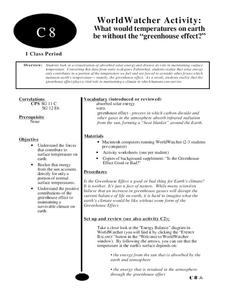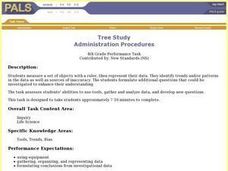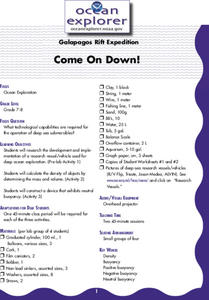Curated OER
Exploring Levers
Students examine the parts of a lever system and their functions. In this simple machines lesson students study the different classes of levers and what they are used for.
Curated OER
Measurement: Length, volume, and temperature
Young scholars determine the temperature of the water in a cup, measure the length of a piece of cardboard, and measure out an appropriate volume of water. This task assesses student's abilities to perform measurement and reporting skills.
Curated OER
Classifying Rocks
Young scholars classify rocks into groups after they observe the rocks and identify properties that can be used to divide them into groups. They then identify other properties that could be used to classify other objects into groups.
Curated OER
What Floats Your Boat?
Young scholars discover the Archimedes principle through a buoyancy experiment. They measure the water displacement of a lump a clay which is denser than water then reshape the clay into a bowl which floats but displaces more water.
Curated OER
Greenhouse Effect and Temperature
Students look at a visualization of absorbed solar energy and discuss its role in maintaining surface temperature. They examine greenhouse effect and its role in maintaining a climate in which humans can survive.
Curated OER
Mystery Card 3
Students will make a circuit on a mystery card. They will connect wires, bulbs, and battery to form an electrical tester. After students learn how to make one following the directions, they can create their own mystery card by...
Curated OER
Mystery Card 2
Students make a circuit on a mystery card. They then use an electrical tester to determine where electricity flows between circles on the card. They will connect wires, bulbs, and a battery to form an electrical tester.
Curated OER
Mystery Card 1
Learners test their knowledge of electrical conductors and circuits by constructing an electric tester and using it to determine where electricity flows between circles on a mystery card.
Curated OER
Tree Study
Students measure the lengths of provided leafs to the nearest millimeter. Students identify trends in the data as well as sourced of inaccuracy and formulate additional questions that could be investigated to enhance their understanding.
Curated OER
Galapagos Rift Expedition Come On Down!
Students research the development and implementation of a research vessel/vehicle used for deep ocean exploration. In this oceanography lesson plan, students calculate the density of objects by determining the mass and volume.
DiscoverE
Friction in Action
There's no need to have friction among instructors regarding the resource. Pupils investigate how marbles and coins slide along different surfaces which gives them information to estimate coefficients of friction.
Curated OER
Building Bridges
Students identify the different types of bridges. Using the internet, they research information on how they are built by completing a scavenger hunt. Locating a specific area, they determine which type of bridge would be appropriate and...
Curated OER
Plastic Wrap
Students compare the price and quality of different kinds of plastic kitchen wraps and then rank them from best to worst. They take into account how well it comes out of the roll, if it seals well, it is tangles, how much weight it...
Curated OER
IS MASS THE SAME AS WEIGHT?
Students see the difference between weight and mass when they examine the method of measuring each of them.
Curated OER
Beach Zonation
Students identify and separate the different zones of the beach by observation. They investigate beach zonation by gathering and comparing sand samples gathered from different areas of the beach.
















